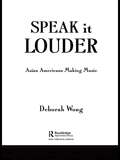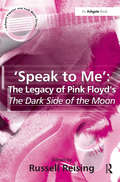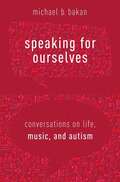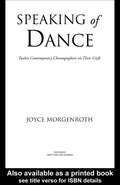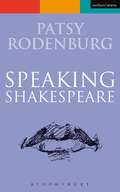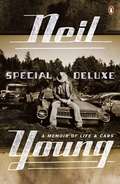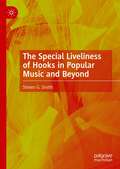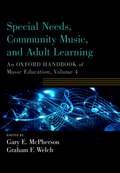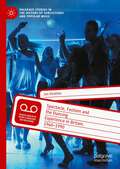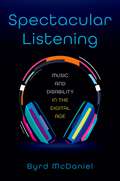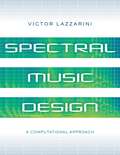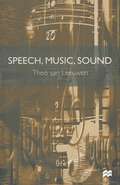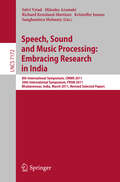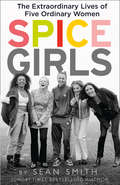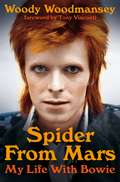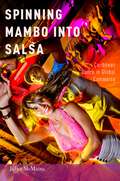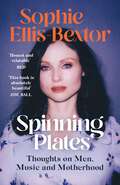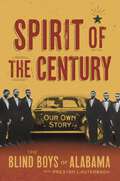- Table View
- List View
Speak it Louder: Asian Americans Making Music
by Deborah WongSpeak It Louder: Asian Americans Making Music documents the variety of musics-from traditional Asian through jazz, classical, and pop-that have been created by Asian Americans. This book is not about "Asian American music" but rather about Asian Americans making music. This key distinction allows the author to track a wide range of musical genres. Wong covers an astonishing variety of music, ethnically as well as stylistically: Laotian song, Cambodian music drama, karaoke, Vietnamese pop, Japanese American taiko, Asian American hip hop, and panethnic Asian American improvisational music (encompassing jazz and avant-garde classical styles). In Wong's hands these diverse styles coalesce brilliantly around a coherent and consistent set of questions about what it means for Asian Americans to make music in environments of inter-ethnic contact, about the role of performativity in shaping social identities, and about the ways in which commercially and technologically mediated cultural production and reception transform individual perceptions of time, space, and society. Speak It Louder: Asian Americans Making Music encompasses ethnomusicology, oral history, Asian American studies, and cultural performance studies. It promises to set a new standard for writing in these fields, and will raise new questions for scholars to tackle for many years to come.
'Speak to Me': The Legacy of Pink Floyd's The Dark Side of the Moon
by Russell ReisingThe endurance of Pink Floyd's The Dark Side of the Moon on the Billboard Top 100 Chart is legendary, and its continuing sales and ongoing radio airplay ensure its inclusion on almost every conceivable list of rock's greatest albums. This collection of essays provides indispensable studies of the monumental 1973 album from a variety of musical, cultural, literary and social perspectives. The development and change of the songs is considered closely, from the earliest recordings through to the live, filmed performance at London's Earls Court in 1994. The band became almost synonymous with audio-visual innovations, and the performances of the album at live shows were spectacular moments of mass-culture although Roger Waters himself spoke out against such mass spectacles. The band's stage performances of the album serve to illustrate the multifaceted and complicated relationship between modern culture and technology. The album is therefore placed within the context of developments in late 1960s/early 1970s popular music, with particular focus on the use of a variety of segues between tracks which give the album a multidimensional unity that is lacking in Pink Floyd's later concept albums. Beginning with 'Breathe' and culminating in 'Eclipse', a tonal and motivic coherence unifies the structure of this modern song cycle. The album is also considered in the light of modern day 'tribute' bands, with a discussion of the social groups who have the strongest response to the music being elaborated alongside the status of mediated representations and their relation to the 'real' Pink Floyd.
'Speak to Me': The Legacy of Pink Floyd's The Dark Side of the Moon
by Russell ReisingThe endurance of Pink Floyd's The Dark Side of the Moon on the Billboard Top 100 Chart is legendary, and its continuing sales and ongoing radio airplay ensure its inclusion on almost every conceivable list of rock's greatest albums. This collection of essays provides indispensable studies of the monumental 1973 album from a variety of musical, cultural, literary and social perspectives. The development and change of the songs is considered closely, from the earliest recordings through to the live, filmed performance at London's Earls Court in 1994. The band became almost synonymous with audio-visual innovations, and the performances of the album at live shows were spectacular moments of mass-culture although Roger Waters himself spoke out against such mass spectacles. The band's stage performances of the album serve to illustrate the multifaceted and complicated relationship between modern culture and technology. The album is therefore placed within the context of developments in late 1960s/early 1970s popular music, with particular focus on the use of a variety of segues between tracks which give the album a multidimensional unity that is lacking in Pink Floyd's later concept albums. Beginning with 'Breathe' and culminating in 'Eclipse', a tonal and motivic coherence unifies the structure of this modern song cycle. The album is also considered in the light of modern day 'tribute' bands, with a discussion of the social groups who have the strongest response to the music being elaborated alongside the status of mediated representations and their relation to the 'real' Pink Floyd.
Speaking For Ourselves: Conversations On Life, Music, And Autism
by Michael B. Bakan Dotan Nitzberg Mara Chasar Graeme Gibson Elizabeth J. Grace Zena Hamelson Gordon PetersonSince advent of autism as a diagnosed condition in the 1940s, the importance of music in the lives of autistic people has been widely observed and studied. Articles on musical savants, extraordinary feats of musical memory, unusually high rates of absolute or "perfect" pitch, and the effectiveness of music-based therapies abound in the autism literature. Meanwhile, music scholars and historians have posited autism-centered explanatory models to account for the unique musical artistry of everyone from Béla Bartók and Glenn Gould to "Blind Tom" Wiggins. Given the great deal of attention paid to music and autism, it is surprising to discover that autistic people have rarely been asked to account for how they themselves make and experience music or why it matters to them that they do. In Speaking for Ourselves, renowned ethnomusicologist Michael Bakan does just that, engaging in deep conversations - some spanning the course of years - with ten fascinating and very different individuals who share two basic things in common: an autism spectrum diagnosis and a life in which music plays a central part. These conversations offer profound insights into the intricacies and intersections of music, autism, neurodiversity, and life in general, not from an autistic point of view, but rather from many different autistic points of view. They invite readers to partake of a rich tapestry of words, ideas, images, and musical sounds (on the companion website) that speak to both the diversity of autistic experience and the common humanity we all share.
Speaking of Dance: Twelve Contemporary Choreographers on Their Craft
by Joyce MorgenrothSpeaking of Dance: Twelve Contemporary Choreographers on Their Craft delves into the choreographic processes of some of America's most engaging and revolutionary dancemakers. Based on personal interviews, the book's narratives reveal the methods and quests of, among others, Merce Cunningham, Meredith Monk, Bill T. Jones, Trisha Brown, and Mark Morris. Morgenroth shows how the ideas, craft, and passion that go into their work have led these choreographers to disrupt known forms and expectations. The history of dance in the making is revealed through the stories of these intelligent, articulate, and witty dance masters.
Speaking of Dance: Twelve Contemporary Choreographers on Their Craft
by Joyce MorgenrothSpeaking of Dance: Twelve Contemporary Choreographers on Their Craft delves into the choreographic processes of some of America's most engaging and revolutionary dancemakers. Based on personal interviews, the book's narratives reveal the methods and quests of, among others, Merce Cunningham, Meredith Monk, Bill T. Jones, Trisha Brown, and Mark Morris. Morgenroth shows how the ideas, craft, and passion that go into their work have led these choreographers to disrupt known forms and expectations. The history of dance in the making is revealed through the stories of these intelligent, articulate, and witty dance masters.
Special Deluxe: Mi Vida Al Volante
by Neil YoungSpecial Deluxe by Neil Young - the second installment of the iconic musician's memoirsQuirky and wonderfully candid, Neil Young's new book of reminiscences is as compelling as his first book. He returns with more unforgettable stories about his six decades in the music business - but this is not your average rock biography. He centres this new work on one of his life's passions, cars, using the framework of all the cars he's ever owned to construct a narrative of his life and career, exploring and demonstrating how memories are attached to objects. Young also expresses regret for the environmental impact of his past cars, and now passionately advocates the use of clean energy.Special Deluxe is a mix of memoir and environmental politics by one of the most gifted and influential artists of our time.The next installment of Neil Young's memoir after Waging Heavy Peace, Special Deluxe is essential reading for his fans and will also appeal to readers of Life by Keith Richards and Chronicles by Bob Dylan.'Not your average rock-star autobiography .... Young is a natural obsessive and a bit cantankerous, which makes an interesting combination' Richard Williams, Guardian'Waging Heavy Peace is as charismatically off the wall as Neil Young's records' Janet Maslin, New York TimesNeil Young's music and songwriting span forty years, and his 34 studio albums are among the most enduring and popular in modern times. Born and raised in Canada, long resident in California, he has been uniquely inducted twice into the Rock and Roll Hall of Fame. He is also well-known as a political activist, environmentalist and philanthropist, co-founding Farm Aid and The Bridge School for educationally impaired children.
The Special Liveliness of Hooks in Popular Music and Beyond
by Steven G. SmithThis book illuminates the aesthetically underrated meaningfulness of particular elements in works of art and aesthetic experiences generally. Beginning from the idea of "hooks" in popular song, the book identifies experiences of special liveliness that are of enduring interest, supporting contemplation and probing discussion. When hooks are placed in the foreground of aesthetic experience, so is an enthusiastic “grabbing back” by the experiencer who forms a quasi-personal bond with the beloved singular moment and is probably inclined to share this still-evolving realization of value with others. This book presents numerous models of enthusiastic “grabbing back” that are art-critically motivated to explain how hooks achieve their effects and philosophically motivated to discover how hooks and hook appreciation contribute to a more ideally desirable life. Framing hook appreciation with a defensible general model of aesthetic experience, this book gives an unprecedented demonstration of the substantial aesthetic and philosophical interest of hook-centered inquiry.
Special Needs, Community Music, and Adult Learning: An Oxford Handbook of Music Education, Volume 4 (Oxford Handbooks)
by Gary E. McPherson and Graham F. WelchSpecial Needs, Community Music, and Adult Learning is one of five paperback books derived from the foundational two-volume Oxford Handbook of Music Education. Designed for music teachers, students, and scholars of music education, as well as educational administrators and policy makers, this fourth book in the set focuses on issues and topics that help to broaden conceptions of music and musical involvement, while recognizing that development occurs through many forms. The first section addresses music education for those with special abilities and special needs; authors explore many of the pertinent issues that can promote or hinder learners who share characteristics, and delve deep into what it means to be musical. The second section of the volume addresses music as a shared, community experience, and the diverse and constantly evolving international practice of community music. The chapters in the third section provide evidence that the process of music education exists as a lifelong continuum that encompasses informal, formal, and non-formal methods alike. The authors encourage music educators to think in terms of a music learning society, where adult education is not peripheral to the priority of other age groups, but is instead fully integral to a vision for the good of society. By developing sound pedagogical approaches that are tailored to take account of all learners, the volume endeavors to move from making individual adaptations towards designing sensitive 'universal' solutions. Contributors Carlos R. Abril, Mary Adamek, Kenneth S. Aigen, Chelcy Bowles, Mary L. Cohen, William M. Dabback, Alice-Ann Darrow, John Drummond, Cochavit Elefant, David J. Elliott, Lee Higgins, Valentina Iadeluca, Judith A. Jellison, Janet L. Jensen, Patrick M. Jones, Jody L. Kerchner, Thomas W. Langston, Andreas C. Lehmann, Katrina McFerran, Gary E. McPherson, David Myers, Adam Ockelford, Helen Phelan, Andrea Sangiorgio, Laya H. Silber, Marissa Silverman, Rineke Smilde, David S. Smith, Kari K. Veblen, Janice Waldron, Graham F. Welch
Special Needs, Community Music, and Adult Learning: An Oxford Handbook of Music Education, Volume 4 (Oxford Handbooks)
Special Needs, Community Music, and Adult Learning is one of five paperback books derived from the foundational two-volume Oxford Handbook of Music Education. Designed for music teachers, students, and scholars of music education, as well as educational administrators and policy makers, this fourth book in the set focuses on issues and topics that help to broaden conceptions of music and musical involvement, while recognizing that development occurs through many forms. The first section addresses music education for those with special abilities and special needs; authors explore many of the pertinent issues that can promote or hinder learners who share characteristics, and delve deep into what it means to be musical. The second section of the volume addresses music as a shared, community experience, and the diverse and constantly evolving international practice of community music. The chapters in the third section provide evidence that the process of music education exists as a lifelong continuum that encompasses informal, formal, and non-formal methods alike. The authors encourage music educators to think in terms of a music learning society, where adult education is not peripheral to the priority of other age groups, but is instead fully integral to a vision for the good of society. By developing sound pedagogical approaches that are tailored to take account of all learners, the volume endeavors to move from making individual adaptations towards designing sensitive 'universal' solutions. Contributors Carlos R. Abril, Mary Adamek, Kenneth S. Aigen, Chelcy Bowles, Mary L. Cohen, William M. Dabback, Alice-Ann Darrow, John Drummond, Cochavit Elefant, David J. Elliott, Lee Higgins, Valentina Iadeluca, Judith A. Jellison, Janet L. Jensen, Patrick M. Jones, Jody L. Kerchner, Thomas W. Langston, Andreas C. Lehmann, Katrina McFerran, Gary E. McPherson, David Myers, Adam Ockelford, Helen Phelan, Andrea Sangiorgio, Laya H. Silber, Marissa Silverman, Rineke Smilde, David S. Smith, Kari K. Veblen, Janice Waldron, Graham F. Welch
Spectacle, Fashion and the Dancing Experience in Britain, 1960-1990 (Palgrave Studies in the History of Subcultures and Popular Music)
by Jon StrattonThis book explores dancing from the 1960s to the 1980s; though this period covers only twenty years, the changes during it were seismic. Nevertheless continuities can be found, and those are what this book examines. In dancing, it answers how we moved from the self-control that formed the basis for ballroom dancing, to ecstatic rave dancing. In terms of music, it answers how we moved from the beat groups to electronic dance music. In terms of youth, it answers how we moved from youth culture to club culture.
Spectacular Listening: Music and Disability in the Digital Age
by Byrd McDanielImagine a powerful listening experience that you want to share with others. You could describe it to someone with words, or you may choose a flashier alternative. You could, for example, costume yourself and take to the stage in a famous concert venue, delivering a rousing air guitar interpretation of a beloved rock solo for a live audience. Maybe you seek something more subtle, so you pull out your smartphone and record yourself lip-syncing to a guilty pleasure, showing your followers how seamlessly the music fits your movements. Perhaps instead you want others to hear how the music makes you feel, which leads you to record a podcast episode that translates the thrill of listening into audible exclamations. In ways both mundane and sensational, listening can be an expressive act, enabling people to stage consumption as a public practice -- what author Byrd McDaniel calls "spectacular listening." Contemporary digital platforms not only support such activity but actively encourage people to package personal music reception into a performance that may be widely shared. With a range of compelling ethnographic case studies, McDaniel investigates a broad shift in contemporary listening norms and the stakes for listeners with disabilities. He reveals how listening-as-performance can be an opportunity for play, as well as a critical practice that exposes ableism in music institutions, technologies, and discourse.
Spectacular Listening: Music and Disability in the Digital Age
by Byrd McDanielImagine a powerful listening experience that you want to share with others. You could describe it to someone with words, or you may choose a flashier alternative. You could, for example, costume yourself and take to the stage in a famous concert venue, delivering a rousing air guitar interpretation of a beloved rock solo for a live audience. Maybe you seek something more subtle, so you pull out your smartphone and record yourself lip-syncing to a guilty pleasure, showing your followers how seamlessly the music fits your movements. Perhaps instead you want others to hear how the music makes you feel, which leads you to record a podcast episode that translates the thrill of listening into audible exclamations. In ways both mundane and sensational, listening can be an expressive act, enabling people to stage consumption as a public practice -- what author Byrd McDaniel calls "spectacular listening." Contemporary digital platforms not only support such activity but actively encourage people to package personal music reception into a performance that may be widely shared. With a range of compelling ethnographic case studies, McDaniel investigates a broad shift in contemporary listening norms and the stakes for listeners with disabilities. He reveals how listening-as-performance can be an opportunity for play, as well as a critical practice that exposes ableism in music institutions, technologies, and discourse.
Spectacular Listening: Music and Disability in the Digital Age
by Byrd McDanielImagine a powerful listening experience that you want to share with others. You could describe it to someone with words, or you may choose a flashier alternative. You could, for example, costume yourself and take to the stage in a famous concert venue, delivering a rousing air guitar interpretation of a beloved rock solo for a live audience. Maybe you seek something more subtle, so you pull out your smartphone and record yourself lip-syncing to a guilty pleasure, showing your followers how seamlessly the music fits your movements. Perhaps instead you want others to hear how the music makes you feel, which leads you to record a podcast episode that translates the thrill of listening into audible exclamations. In ways both mundane and sensational, listening can be an expressive act, enabling people to stage consumption as a public practice -- what author Byrd McDaniel calls "spectacular listening." Contemporary digital platforms not only support such activity but actively encourage people to package personal music reception into a performance that may be widely shared. With a range of compelling ethnographic case studies, McDaniel investigates a broad shift in contemporary listening norms and the stakes for listeners with disabilities. He reveals how listening-as-performance can be an opportunity for play, as well as a critical practice that exposes ableism in music institutions, technologies, and discourse.
Spectral Music Design: A Computational Approach
by Victor LazzariniProcessing audio in the spectral domain has become a practical proposition for a variety of applications in computer music, composition, and sound design, making it an area of significant interest for musicians, programmers, sound designers, and researchers. While spectral processing has been explored already from a variety of perspectives, previous approaches tended to be piecemeal: some dealt with signal processing details, others with a high-level music technology discussion of techniques, some more compositionally focused, and others at music/audio programming concerns. As author Victor Lazzarini argues, the existing literature has made a good footprint in the area but has failed to integrate these various approaches within spectral audio. In Spectral Sound Design: A Computational Approach, Lazzarini provides an antidote. Spectral Sound Design: A Computational Approach gives authors a set of practical tools to implement processing techniques and algorithms in a balanced way, covering application aspects as well the fundamental theory that underpins them, within the context of contemporary and electronic music practice. The book employs a mix of Python for prototyping and Csound for deployment and music programming. The tight integration of these three languages as well as the wide scope offered by the combination (going from embedded to supercomputing, and including web-based and mobile applications) makes it the go-to resource to deal with the practical aspects of the subject.
Spectral Music Design: A Computational Approach
by Victor LazzariniProcessing audio in the spectral domain has become a practical proposition for a variety of applications in computer music, composition, and sound design, making it an area of significant interest for musicians, programmers, sound designers, and researchers. While spectral processing has been explored already from a variety of perspectives, previous approaches tended to be piecemeal: some dealt with signal processing details, others with a high-level music technology discussion of techniques, some more compositionally focused, and others at music/audio programming concerns. As author Victor Lazzarini argues, the existing literature has made a good footprint in the area but has failed to integrate these various approaches within spectral audio. In Spectral Sound Design: A Computational Approach, Lazzarini provides an antidote. Spectral Sound Design: A Computational Approach gives authors a set of practical tools to implement processing techniques and algorithms in a balanced way, covering application aspects as well the fundamental theory that underpins them, within the context of contemporary and electronic music practice. The book employs a mix of Python for prototyping and Csound for deployment and music programming. The tight integration of these three languages as well as the wide scope offered by the combination (going from embedded to supercomputing, and including web-based and mobile applications) makes it the go-to resource to deal with the practical aspects of the subject.
Speech, Music, Sound
by Theo Van LeeuwenThis book explores what speech, music and other sounds have in common. It gives a detailed description of the way perspective, rhythm, textual quality and other aspects of sound are used to communicate emotion and meaning. It draws on a wealth of examples from radio (disk jockey and newsreading speech, radio plays, advertising jingles, news signature tunes), film soundtracks (The Piano, The X-files, Disney animation films), music ranging from medieval plain chant to drum 'n' bass and everyday soundscapes.
Speech, Sound and Music Processing: 8th International Symposium, CMMR 2011 and 20th International Symposium, FRSM 2011, Bhubaneswar, India, March 9-12, 2011, Revised Selected Papers (Lecture Notes in Computer Science #7172)
by Sølvi Ystad Mitsuko Aramaki Richard Kronland-Martinet Kristoffer Jensen Sanghamitra MohantyThis book constitutes the thoroughly refereed post-proceedings of the 8th International Symposium on Computer Music Modeling and Retrieval, CMMR 2011 and the 20th International Symposium on Frontiers of Research in Speech and Music, FRSM 2011. This year the 2 conferences merged for the first time and were held in Bhubanes, India, in March 2011. The 17 revised full papers presented were specially reviewed and revised for inclusion in this proceedings volume. The book is divided in four main chapters which reflect the high quality of the sessions of CMMR 2011, the collaboration with FRSM 2011 and the Indian influence, in the topics of Indian Music, Music Information Retrieval, Sound analysis synthesis and perception and Speech processing of Indian languages.
Spice Girls: The Story of the World’s Greatest Girl Band
by Sean Smith‘Get the inside scoop on all things Spice!’ OK! Magazine 'A compelling new book' Daily Express Intimate and revealing, Spice Girls is the definitive story of the world’s most iconic girl group.
Spider from Mars: My Life with Bowie
by Woody WoodmanseyFor many fans, David Bowie's Ziggy Stardust era remains the most extraordinarily creative period in his career. As a member of Bowie's legendary band at the time - The Spiders From Mars - Woody Woodmansey played drums on four seminal albums: The Man Who Sold The World, Hunky Dory, The Rise And Fall Of Ziggy Stardust And The Spiders From Mars and Aladdin Sane. Woody's memoir, which he started work on in 2014, focuses on this key period and brings it to glorious life. With the confidence of youth, Woody always thought he'd be in a famous band but the nineteen-year-old rocker from Hull never expected to be thrust into London's burgeoning glam rock scene, and also into a bottle-green velvet suit and girl's shoes. Playing with Bowie took him on an eye-opening and transformative journey. In Spider From Mars he writes candidly about the characters who surrounded Bowie, recalling the album sessions as well as behind-the-scenes moments with one of the world's most iconic singers. The result is an insightful, funny, poignant memoir that lovingly evokes a seminal moment in music history and pays tribute to one of the most outstanding and innovative talents of our time.
Spinning Mambo into Salsa: Caribbean Dance in Global Commerce
by Juliet McMainsArguably the world's most popular partnered social dance form, salsa's significance extends well beyond the Latino communities which gave birth to it. The growing international and cross-cultural appeal of this Latin dance form, which celebrates its mixed origins in the Caribbean and in Spanish Harlem, offers a rich site for examining issues of cultural hybridity and commodification in the context of global migration. Salsa consists of countless dance dialects enjoyed by varied communities in different locales. In short, there is not one dance called salsa, but many. Spinning Mambo into Salsa, a history of salsa dance, focuses on its evolution in three major hubs for international commercial export-New York, Los Angeles, and Miami. The book examines how commercialized salsa dance in the 1990s departed from earlier practices of Latin dance, especially 1950s mambo. Topics covered include generational differences between Palladium Era mambo and modern salsa; mid-century antecedents to modern salsa in Cuba and Puerto Rico; tension between salsa as commercial vs. cultural practice; regional differences in New York, Los Angeles, and Miami; the role of the Web in salsa commerce; and adaptations of social Latin dance for stage performance. Throughout the book, salsa dance history is linked to histories of salsa music, exposing how increased separation of the dance from its musical inspiration has precipitated major shifts in Latin dance practice. As a whole, the book dispels the belief that one version is more authentic than another by showing how competing styles came into existence and contention. Based on over 100 oral history interviews, archival research, ethnographic participant observation, and analysis of Web content and commerce, the book is rich with quotes from practitioners and detailed movement description.
SPINNING MAMBO INTO SALSA C: Caribbean Dance in Global Commerce
by Juliet McMainsArguably the world's most popular partnered social dance form, salsa's significance extends well beyond the Latino communities which gave birth to it. The growing international and cross-cultural appeal of this Latin dance form, which celebrates its mixed origins in the Caribbean and in Spanish Harlem, offers a rich site for examining issues of cultural hybridity and commodification in the context of global migration. Salsa consists of countless dance dialects enjoyed by varied communities in different locales. In short, there is not one dance called salsa, but many. Spinning Mambo into Salsa, a history of salsa dance, focuses on its evolution in three major hubs for international commercial export-New York, Los Angeles, and Miami. The book examines how commercialized salsa dance in the 1990s departed from earlier practices of Latin dance, especially 1950s mambo. Topics covered include generational differences between Palladium Era mambo and modern salsa; mid-century antecedents to modern salsa in Cuba and Puerto Rico; tension between salsa as commercial vs. cultural practice; regional differences in New York, Los Angeles, and Miami; the role of the Web in salsa commerce; and adaptations of social Latin dance for stage performance. Throughout the book, salsa dance history is linked to histories of salsa music, exposing how increased separation of the dance from its musical inspiration has precipitated major shifts in Latin dance practice. As a whole, the book dispels the belief that one version is more authentic than another by showing how competing styles came into existence and contention. Based on over 100 oral history interviews, archival research, ethnographic participant observation, and analysis of Web content and commerce, the book is rich with quotes from practitioners and detailed movement description.
Spinning Plates: Music, Men, Motherhood and Me: THE AUTOBIOGRAPHY
by Sophie Ellis-BextorSOPHIE ELLIS-BEXTOR SINGER - SINGER, WRITER AND PIONEER OF THE LOCKDOWN KITCHEN DISCO, REFLECTS CANDIDLY ON LIFE, LOVE AND RELATIONSHIPSSophie Ellis-Bextor's kitchen discos became a source of escapism, catharsis and sequined joy for a swathe of the population during lockdown. From knackered mothers and fed up fathers, to cooped up partiers with nowhere to go, Sophie's gloriously chaotic Friday kitchen performances have cheered and revived us. Now Sophie is bringing that same mixture of down to earth candour and optimistic sparkle to her autobiography. In SPINNING PLATES Sophie writes openly and very frankly about her life. From a childhood flogging Blue Peter badges in the playground to joining Theaudience straight from school, to finding love after a dark and troubled relationship, and becoming mother to five boys, Sophie pulls no punches in her autobiography.By choosing to speak so openly on issues close to her heart, Sophie invites us all to join the conversation and bring those trickier subjects out of the shadows and into the light.Covering relationships, body image, good-enough parenting, the highs - and the lows - of competing on Strictly Come Dancing - Sophie writes about the things that take on greater and lesser importance as life becomes more complicated. This is a book about respecting and learning from our mistakes and experiences and not being afraid to smash a few plates for the sake of what we actually need, want and value.Honest, heartfelt and highly entertaining.
Spirit of the Century: Our Own Story
by The Blind Boys of AlabamaAn insider history of the Blind Boys of Alabama, the longest running group in American music, and the untold story of their world, written with band members and key musical colleagues. The Blind Boys of Alabama are the quintessential Gospel vocal group, and the longest-running musical institution in America. Their story intersects with pivotal moments and issues in American history and is an ideal prism through which to trace music, culture, history, and race in America. Spirit of the Century invites readers to follow along the Blind Boys&’ eight-decade journey together from a segregated trade school, through the rough and tumble indie record game and grinding tour schedule of the golden age of gospel, to starring in an iconic Broadway musical, performing at the White House for three presidents twice, collaborating with Tom Petty, Lou Reed, and Ben Harper, among others, singing the theme song for &“The Wire,&” and winning five Grammys. More than just a story of the Blind Boys' illustrious career, Spirit of the Century also sheds new light on the larger world of African American gospel music, its origins, and the colorful characters at its center. Though there have been several iterations of the group over the decades, Spirit of the Century rounds up all surviving members of the group as contributors to the telling of their own story, and a result, the book offers a unique and intimate perspective on the group's enduring success. Current drummer and road manager Rickie McKinney has been with the group throughout its renaissance, while guitarist Joey Williams, the group&’s sighted member, has been the eyes of the Blind Boys since 1992. Octogenarian Jimmy Lee Carter has a fascinating history, as a fellow student of the original but deceased Blind Boys Clarence Fountain, George Scott, Olice Thomas, Johnny Fields, J.T. Hutton, and Velma Traylor at the Talladega school. Carter is one of a few performers who have been in both the Blind Boys of Alabama and Mississippi. He fronts the Alabama group today as a classic quartet leader and fiery preacher. Along with extensive interviews of Fountain, these legendary musicians provide this book with the voice, firsthand perspective, and authenticity that bring their story the same inspirational power that you hear in their songs. Thought-provoking, heartfelt, and deeply inspiring, Spirit of the Century is a fascinating and one-of-a-kind read that you won't be able to put down.
